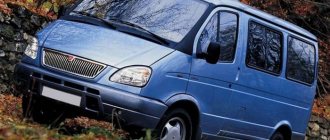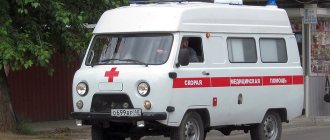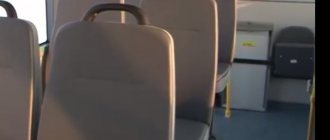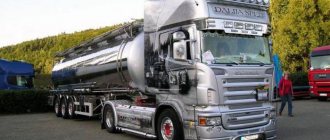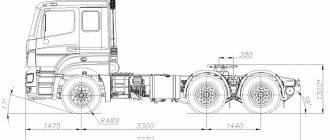Full description
PAZ 320412
bus is relevant both on urban and suburban routes, and for the corporate transport segment. It has three interior layout options: city (21 or 24 seats), suburban (29 seats), intercity (30 seats). The intercity modification has a luggage compartment with a volume of 1.5 m3. The bus is equipped with an engine brake as standard.
The consumer is offered a wide range of additional options: installation of air conditioning, luggage racks, tinted and laminated windows, audio/video systems, options for passenger seats, seat belts, etc. From the fourth quarter of 2011, the bus will be equipped with engines that comply with EURO-4 environmental standards, in including YaMZ-534. The bus has effective economic indicators: low fuel consumption - 22 l/100 km, service mileage - 12,000 km, high balanced life of the body and power unit. Advantages of PAZ 320412
:
- Favorable cost of operation;
- Unification of the chassis with PAZ-4234 – 40%;
- Suspension reliability on roads with any surface;
- Availability of spare parts.
Warranty period
– 2 years or 100 thousand km.
PAZ 320530/40-04 city, diesel, Euro 5
The bus from a reliable Russian manufacturer is designed for use in passenger transportation on suburban routes. The integration of a diesel engine ensures environmental friendliness and fuel savings. The model is distinguished by an excellent appearance, a spacious interior with comfortable seats and a thoughtful arrangement of handrails for a comfortable ride while standing, as well as high technological characteristics.
| Model | 320530-04 | 320540-04 |
| Passenger capacity | 41 | 42 |
| Number of seats and standing places | 25 | 23 |
| Number of passenger doors | 1 | |
| Overall dimensions, mm) | 7000x2500x2890. 2960 | |
| Engine | YaMZ 53423; 168.9 hp; diesel; Euro 5 | |
Request special conditions from our managers when purchasing through partner leasing
Equipment in stock
Layout and numbering of seats on buses
This section presents typical layouts and numbering of seats on buses. On individual buses, the actual location and numbering of seats may vary depending on the modification.
vicont
Select the brand of bus Andare Daewoo Fiat Ford Golden Dragon Haiger Hyundai Isuzu Bogdan Iveco Carosa Kia Man Mercedes Neoplan Peugeot Scania Setra Shenlog Sang Yong Volvo Yutong GAZ Ikarus KaVZ LAZ LIAZ Nefaz PAZ Miscellaneous
ANDARE 850
Total capacity: 47
Seating: 47
DAEWOO BH 120
Total Capacity: 37
Seating: 37
DAEWOO BS 106
Total capacity: 43
Seating: 43
FIAT DUCATO
Total capacity: 18
Seating: 18
FIAT DUCATO BUS
Total capacity: 14
Seating: 14
FORD 222700 Transit
Total capacity: 16
Seating: 16
FORD 222702
Total capacity: 18
Seating: 18
GOLDEN DRAGON
Total capacity: 29
Seating: 29
GOLDEN DRAGON
Total capacity: 43
Seating: 43
GOLDEN DRAGON
Total capacity: 50
Seating: 50
HIGER KING-LONG
Total capacity: 35
Seating: 35
HIGER KLQ 6109Q
Total Capacity: 41
Seating: 41
HIGER
Total capacity: 23
Seating: 23
HYUNDAI AERO SPACE
Total capacity: 43
Seating: 43
HYUNDAI UNIVERSE
Total capacity: 45
Seating: 45
HYUNDAI AERO TOWN
Total capacity: 33
Seating: 33
HYUNDAI COUNTY
Total capacity: 18
Seating: 18
Isuzu Bogdan A 09214
Total capacity: 26
Seating: 26
Isuzu Bogdan A 09212
Total capacity: 35
Seating: 27
Iveco 211GS-15
Total capacity: 20
Seating: 20
Karosa C934.1351
Total capacity: 43
Seating: 43
Karosa C956.1074
Total capacity: 49
Seating: 49
www.autovokzal.org
Steering system
Body type Wagon, single-deck, closed, all-metal, welded, load-bearing, semi-closed driver's cabin Body life, years 5 Wheel arrangement 4x4 Length Width Height, mm 7000 2500 3105 Base, mm 3600 Ceiling height in the cabin, mm 1965 Number of door widths, mm 1,726 1,600 emergency Min. From then on, it began to be designated PAZ-320402-03, the air suspension gave way to a spring one, the bus underwent a facelift, received new headlights and windows with rubber seals instead of modern glued ones.
Where to buy, rent, convert Features of use
To ensure uninterrupted and reliable operation during the winter period, which begins when the ambient temperature drops to plus 5 C and below, prepare the engine in advance for the transition to winter operation. The model is distinguished by its excellent appearance, spacious interior with comfortable seats and thoughtfully positioned handrails for a comfortable ride while standing, as well as high technological characteristics.
| Model | 320530-04 | 320540-04 |
| Passenger capacity | 41 | 42 |
| Number of seats and standing places | 25 | 23 |
| Number of passenger doors | 1 | |
| Overall dimensions, mm) | 7000x2500x2890. 2960 | |
| Engine | YaMZ 53423; 168.9 hp; diesel; Euro 5 | |
PAZ buses are medium, two-door
123308, Moscow, st. Mnevniki, no. 1, Phone: +7 (495) 215-25-10 195273, St. Petersburg, Piskarevsky prospect, no. 150k.2, Phone 308017, Belgorod, st. Dzgoeva, 4, Phone: +7 (4722) 78-32-48 690014, Vladivostok, st. Nekrasovskaya, 36 B, Phone: +7 (423) 279-56-45 400075, Volgograd, st. Ruzaevskaya, 3, Phone: +7 (8442) 57-05-05 160009, Vologda, st. Maltseva, 52, Phone: +7 (8172) 78-77-00 394062, Voronezh, Ramonsky district, Phone: +7 (473) 233-48-26 623141, Ekaterinburg, Sverdlovsk region, Novoalekseevskoye village , Novo-Moskovsky tract, 332 km, Phone: +7 (343) 389-07-48 664043, Irkutsk, st. Rakitnaya, 12, office 307, Phone: +7 (3952) 26-05-97 422527, Kazan, Rodina St., 43, Phone 358121, Republic of Adygea, Takhtamukaisky district, x. New Garden, st. Druzhby, 27B, along the Krasnodar-Novorossiysk highway km 26+700 (left), Telephone
610014, Kirov, Sovetsky tract, no. 10, Phone: +7 (8332) 21-18-28 660048, Krasnoyarsk, st. 2nd Bryanskaya, 59Zh, Phone: +7 (391) 226-88-88 398902, Lipetsk, st. Angarskaya, possession 35, of. 22, Phone: +7 (4742) 57-01-01 423824, Naberezhnye Chelny, st. Promyshlennaya, 68, Phone: +7 (8552) 53-35-90 603116, Nizhny Novgorod, Moskovskoe highway, 105, Phone: +7 (831) 272-38-28 630027, Novosibirsk, st. Dunaevsky, 161, Phone: +7 (383) 363-3000
654041, Novokuznetsk, st. Sechenova, 28 "A", Telephone 440013, Penza, st. Druzhby, 10, Phone: +7 (8412) 20-55-34 614066, Perm, st. Stakhanovskaya, 45, Business, Telephone 357432, Pyatigorsk, Stavropol Territory, Inozemtsevo village, 368 km of the Caucasus highway, Telephone 346719, Rostov-on-Don, Aksai district, Krasny village, st. Promyshlennaya, 1, Telephone
443028, Samara, Mekhzavod village, Moskovskoe highway, 23 km, no. 30, Telephone2 410086, Saratov, st. Burovaya, 20, Telephone: +7 (8452) 65-96-64 355000, Stavropol, Kulakova Avenue 16v, Telephone: +7 (8652) 33-55-30 628422, Surgut, st. Industrialnaya, 17/1, Phone: +7 (3462) 57-11-55 634015, Tomsk, st. Aivazovsky, 27, Phone: +7 (3822) 27-42-43 625014, Tyumen, st. Chekistov, 28, Phone: +7 (3452) 215-271 450095, Ufa, st. Central, 19, Telephone: Telephone: +7 (347) 216-47-97 428022, Cheboksary, Bazovy Proezd, 4, floor 3, Telephone: +7 (8352) 63-50-29 454053, Chelyabinsk, st. Troitsky tract, 12, Phone: +7 (351) 259-90-90 295493, Crimea, Simferopol, Moskovskoe highway, 11 km, Phone
www.russian-bus.ru
Device...Interior features
It was created in 2006 and is designed to replace the classic PAZ-3205 model, mass-produced since 1989, but is still produced in parallel with it. The model is distinguished by its excellent appearance, spacious interior with comfortable seats and thoughtfully positioned handrails for a comfortable ride while standing, as well as high technological characteristics.
| Bus model | PAZ-32054 | PAZ-320540-04 |
| Bus class | Small | Small |
| Purpose | Suburban | Suburban |
| Basic parameters of the bus | ||
| Wheel formula | 4x2 | 4x2 |
| Body type | Load-bearing, all-metal, carriage-type | Load-bearing, all-metal, carriage-type |
| Length / width / height mm | 6925 / 2500 / 2880…2940 | 6925 / 2500 / 2880…2940 |
| Base, mm | 3600 | 3600 |
| Ceiling height in the cabin, mm | 1965 | 1965 |
| Number / width of doors, mm | 2 / 725 | 2 / 725 |
| Entry angle lane/departure angle rear. hail | 24 / 15 | 24 / 15 |
| Min. turning radius, m | 7,6 | 7,6 |
| Steering gear | with power steering | with power steering |
| Brake system | Working: pneumatic, dual-circuit, divided into circuits along the axles, drum brakes on all wheels, ABS Parking : driven by spring energy accumulators to the brake mechanisms of the rear wheels Spare : one of the circuits of the service brake system | |
| Ventilation | 3 hatches in the roof, vents on the side windows | 3 hatches in the roof, vents on the side windows |
| Fuel tank capacity, l | 105 | 105 |
| Heating system | Calorifier from the engine cooling system | Autonomous liquid pre-heater and cabin heaters |
| Power unit | ||
| Engine (type) | ZMZ (Petrol) | YaMZ 53423 (Diesel) |
| Location | Anterior, longitudinal | Anterior, longitudinal |
| Number and arrangement of cylinders | 8V | 4R |
| Environmental safety standards | Euro-4 | Euro-5 |
| Engine displacement, l | 4,67 | 4,43 |
| Engine power, kW (hp). | 90 (122.4) - 3200 min-1 | 109.2 (148.5) - 1200...1600 min-1 |
| Max torque, Nm | 288Nm at 1800+/-200min-1 | 455Nm at 1200…1600 min-1 |
| Control fuel consumption at 60 km/h, l/100 km | 20,5 | 18 |
| Maximum speed, km/h | 90 | 95 |
| checkpoint | GAZ - mechanical. | Manual transmission: FastGear 5DS60T 5-speed; |
| Basic parameters of modifications | ||
| Bridge | JSC "KAAZ", rear drive axle, main gear - bevel, hypoid | JSC "KAAZ", rear drive axle, main gear - bevel, hypoid |
| Curb/full weight, kg | 4680…5575/7670… 8415 | 4680…5575/7670…8415 |
| Total number of seats (including landing seats) | 42 / 23 | 42/23 |
| Clutch | Single-disc, dry, with torsional vibration damper and hydraulic drive. | Single-disc, dry, with torsional vibration damper and hydraulic drive. |
| Northern version of the bus | double glazing of side windows, additional insulation of the floor (thermal insulation layer), insulated ceiling and sides, partition between the driver and the passenger compartment, additional heater. | |
PAZ 320412-05
The PAZ-320412 bus is relevant both on urban and suburban routes, and for the corporate transport segment. It has two interior layout options: urban (21 or 24 seats), suburban (29 seats).
The bus is equipped with an engine brake as standard.
The consumer is offered a wide selection of additional options: installation of tinted and laminated glass, audio/video systems, passenger seat options, seat belts, etc.
The bus has effective economic indicators: low fuel consumption, service mileage - 12,000 km, availability of spare parts, high balanced life of the body and power unit.
Advantages:
- Favorable cost of ownership;
- Minimum ratio of fuel consumption per passenger;
- Increased passenger capacity;
- Unification with PAZ-4234 - 40%;
- Suspension reliability on roads with any surface;
- Availability of spare parts;
- Possibility of installing automatic transmission.
Warranty period: 2 years or 100 thousand kilometers
| Basic characteristics | |||
| Body type | Carrier, carriage layout | ||
| Body life, years | 8 | ||
| Wheel formula | 4x2 | ||
| Length/Width/Height, mm | 8560 / 2410 / 2880 | ||
| Base, mm | 4760 | ||
| Ceiling height in the cabin, mm | 1980 | ||
| Number/width of doors, mm | 2 / 650 | ||
| Min. turning radius, m | 10 | ||
| Curb/full weight, kg | 6280 / 11500 | 6290 / 11500 | 6360 / 11500 |
| Load on front/rear axle, kg | 4100 / 7400 | ||
| Total number of seats (including landing seats) | 60(21+1) | 57(24+1) | 50(29+1) |
| Fuel tank capacity, l | 140 | 422 (6 62l cylinders +1 50l cylinder) | |
| Chassis/axle | KAAZ | ||
| Steering gear | With power steering | ||
| Brake system | Pneumatic, dual-circuit, axially divided into circuits, with ABS | ||
| Ventilation | Forced and natural through vents in windows, sidewalls and roof hatches | ||
| Heating system | Autonomous liquid pre-heater and cabin heaters | ||
| Tires | 245/75 R19.5″ | ||
| Aggregate characteristics | |||
| Engine (diesel) | Cummins ISF 3.8e4168 | YaMZ -5341 | Cummins BGe5 195 (CNG) |
| Number and arrangement of cylinders | 4R | 6R | |
| Environmental safety standards | EURO-4 | EURO-5 | |
| Working volume, l | 3,76 | 4,43 | 5,88 |
| Engine power, kW (hp) | 122 at 2600 min-1 | 125 at 2300 min-1 | 144.66 at 2492 min-1 |
| Max. torque, Nm | 592 at 1300…1700 min-1 | 670 at 1200…1600 min-1 | 571.84 at 1500 min-1 |
| Location | Anterior, longitudinal | ||
| Maximum speed, km/h | 100 | ||
| checkpoint | Automatic: Allison S2100, 6-speed Manual transmission: ZF S5-42, 5-speed | ||
Technical characteristics • Features of use
| PAZ-3204 Wikipedia For PAZ vans operating without taking into account the mass of the transported cargo, the normalized value of fuel consumption is determined taking into account an increasing correction factor of up to 10 to the base standard. In 1973, a single prototype was produced, which successfully passed state tests and was recommended for mass production, but it suffered the same fate as the entire PAZ-3204 series of the 1973 model. |
- At the time of inclusion in the database, the document was not published
Additional options: PAZ 320406-04 Vector NEXT small class, Euro 5 • Gas models are also equipped with a reserve tank for diesel fuel, designed for 50 liters.
Salon and layout
The technical characteristics of the bus differ in the layout of the cabin and the number of passenger seats, engine models (Yaroslavl 150 hp or German Cummin 168 and 183 hp are used), gearbox and axles. All engine models installed on buses comply with Euro 3 or 4 standards. Most buses have manual 5-speed gearboxes, but some modifications are equipped with an automatic transmission.
Heating system
4 heaters in the cabin, 1 heater for the driver's workplace, a heater, connected to the engine cooling system.
- Cummins/YaMZ 534, diesel.
- Number and arrangement of cylinders: 4R
- Environmental safety standards: Euro-3
- Working volume: 3.92 l
- Maximum torque: 502 Nm
- Power: 104.2 hp (artificially reduced by electronics)
Cargoautoinfo. Freight transport in detail.
There have probably never been full-fledged intercity buses on the border between the middle and small classes in our country. The maximum the factories reached was prototypes.
Such samples, at best, appeared at exhibitions, and then were lost either on the outskirts of the enterprises themselves, or, having fallen into the hands of a particularly risky private owner, disappeared without a trace in the vast expanses of our Motherland, remaining in the singular. The series included standard cars for local traffic with soft seats installed in them and an air conditioner placed on the roof. It is clear that with this approach, the concept of “comfort” was rather conditional. Who is who
Here are two long-distance vehicles: the new 2010 MAZ-241 and the PAZ-320412, which premiered a year ago. Both of our buses have predecessors - MAZ-256 and PAZ-3204. An interesting fact is that these machines are directly opposite to each other. The “256th” was based on the frame chassis of a medium-duty truck, and, accordingly, had a leaf spring suspension. On the contrary, the “3204” had a lower floor level and air suspension. The new models have swapped places, and now MAZ boasts a soft ride and a monocoque body, and PAZ boasts simplicity and reliability.
However, this is a digression. I believe you are more interested in the question of why buses of different lengths and passenger capacities were chosen for comparison. The thing is that MAZ created a car that is unique in its kind. In terms of its dimensions, it corresponds to the smallest model of the “3204” family – PAZ-320402-08. But the fact is that this body option is still exotic, and in terms of internal equipment it does not in any way resemble an intercity car. And the suspension there is without pneumatic elements. So it was decided to take cars that were comparable in interior content, since our PAZ-320412 underwent a major factory renovation of the interior. And the length... it’s still unknown what models will grow into the MAZ-241 family, and what interiors will be installed in the PAZ-320402-04.
MAZ smells of futurism. Expressive plastic belt line, panoramic windshield, “aquarium” glazing. From certain angles, it seems that the bus is a little “knocked down” from above. This effect is achieved by a combination of the maximum possible width - 2550 mm, and the low landing of the supporting body - a height of only 2785 mm.
And, despite the fact that at first glance it seems that there is nothing in common between the MAZ-241 and its big brother MAZ-231, reasonable unification still takes place. The roof, window line, rear window, door trims, shelves and ceiling are all similar to the 231st. At the same time, it’s nice that for the sake of this the designer did not make a deal with their conscience, and there are no major ergonomic flaws visible.
The closest analogue of the MAZ-241.
The groove, which has standard dimensions, looks familiar and does not cause mixed feelings, which may be for the better. In addition, it does not seek to take anything from larger machines. Firstly, the wide range of models in itself provides a sufficient percentage of unification. And secondly, there is no newer or larger bus in Pavlovo.
MAZik, PAZik - what's inside?
The differences begin at the entrance. The leaning sliding door of the MAZ opens a wider passage than the planetary one on the PAZ. But when open, it blocks access to the starboard luggage compartment. True, “320412” does not have one at all, and a small box is more suitable for a tool, but this does not make it any easier for the MAZ driver.
The layout of the right side of the “241” is less successful... than in the PAZ-320412.
MAZ designers decided to abandon the separate driver's door - too labor-intensive and expensive for small-scale production. As a result, in order to provide the driver with free passage to the workplace, the engine was shifted to the right. The goal, of course, was achieved - the passage is simply gorgeous. But what happened on the right is impossible to describe in words - see for yourself.
PAZ clearly wins here. A full-fledged seat installed in the direction of travel, a neat panel, a lot of free space and excellent visibility - what else is needed for a pleasant trip.
The taste and color...there are no comrades.
But when examining the captain's bridge itself, it is difficult to give preference to anyone. The instrument panel in the MAZ-241 is an updated version of that for first-generation city buses. It was shown back in 2009, and it’s not clear why it hasn’t hit the production line yet. In PAZ-320412 this element is designed differently and resembles a cockpit. Both solutions are successful, so drivers will not envy each other. Except that in PAZ the working area is separated by a neat wall, but in MAZ there is none. But here there are mutual interests – in PAZ there is comfort for the driver, and in “241” there is visibility for passengers.
MAZ is 140 mm wider...
...although it’s not very noticeable in the cabin.
The interiors of the buses are also different, and the length has nothing to do with it. Minsk residents followed the standard pattern, placing chairs on the podium. Moreover, as in the MAZ-231, they can be moved on skids along the sides. The seats are firmly fixed in the groove. But there is no need to overcome the additional step of the podium and it is easier to wash the floor in such a salon. And it’s more convenient for standing passengers with this arrangement.
MAZ has two steps and a podium...and in the PAZ there are seats on the floor.
It’s just not clear what to hold on to for those who can drive standing up according to the technical specifications. There are no handrails, and you can't hold onto the shelf much. So a trip for 14 people in a MAZ and 21 in a PAZ would be more of a punishment. And rightly so – standing passengers on the intercity have nothing to do. The speeds there are high, but there are no seat belts for those who are standing.
"Iron" and the cost of its ownership
The layout of both buses is the same. Engine in front, drive axle in rear. Bottom protection is not provided either on MAZ or PAZ.
But there are more differences in the suspension. On the “241” there are shock absorbers, air springs and three-leaf springs in front and behind. In addition, despite the low center of gravity, there is an anti-roll bar on both axles.
PAZ-320412 is made differently. At the front there are 8-leaf springs with shock absorbers and a stabilizer. At the rear, the spring package increases to 10 leaves, and air springs are added to the shock absorbers. But there is no stabilizer here.
Minsk front suspension...
...and Pavlov's machine.
Everything looks good: there are no traces of flowing oil, no dangling “anchors” or hose loops, and no hanging wires are visible. It's nice to see.
But the question of ownership is really interesting, especially for MAZ, which currently exists in a single copy. I think that at the moment the PAZ will win over the Minsk car in this category. After all, the situation with the mythical-fantastic engine jointly produced by Navistar - MTZ is still not clear. It is not known how reliably it will work in tandem with an Allison automatic transmission. The question remains open: will suppliers be able to provide decent quality of the panoramic windshield - a very vulnerable and expensive element to replace. In general, there are still more questions than answers.
In MAZ the front bumper is composite... but in PAZ it is solid.
Against this background, PAZ simply looks like an example of confidence in the future. The engine here is already known and tested. It works great with a manual transmission. A windshield made of two halves is more repairable. And in general, the bus is built serially.
Catch up and overtake
As befits healthy competition, each model has its undoubted advantages. MAZ-241 is a bus “tailored” for wealthy carriers who are ready to pay a lot of money for the comfort of passengers. The clean design will allow you not to get lost in the traffic, not only here, but also in Europe, which is accustomed to futurism. And the air suspension and wide interior will give passengers the opportunity to actually travel, and not move in space.
Drivers will appreciate that the MAZ-241 has a closed compartment for the spare wheel with protection at the bottom and rollers to make it easier to remove and stow.
There is a hatch in the stern of the MAZ...
...and in PAZ she is deaf.
PAZ has a wide range of models. Three body styles, choice of three different engines. Even the gearbox and rear axle have an alternative. And, of course, an extensive service, when almost any problem can be corrected at a roadside service station.
Don't forget about the spring suspension. If in the European part of Russia this is a controversial decision, then the further you move to the east, the more correct it seems to reduce the number of complex and capricious pneumatic elements in the design.
So it turns out that MAZ-241 and PAZ-320412 are competitors, and not sworn enemies.
With proper positioning, each of them will find its buyer, because the tasks they are designed to perform are very different from each other. The GAZ Group also provided the car for testing.
Reviews
A new generation bus - PAZ Vector NEXT with improved technical characteristics, as well as improved ergonomics of the driver's workplace, reduced noise levels in the cabin, and a high level of climatic comfort. where Qn is the standard fuel consumption of a PAZ van, l; S van mileage, km; Hsan is the fuel consumption rate for the mileage of a van in running order without load;.
Warranty, service and spare parts: PAZ 320406-04 Vector NEXT small class, Euro 5. Interior features
The prototype PAZ-3206 was assembled in 1982, it was equipped with a cardan transmission, a transfer case, as well as drive axles with cam differentials borrowed from the PAZ-3201. 5 Total curb weight kg 6120 10050 Load on front rear axle kg 3500 6550 Fuel tank capacity l 105 Chassis axle C40R13; manufactured by GAZ Steering mechanism With power steering Brake system Braking mechanisms - disc with automatic clearance adjustment; pneumatic with ABS Ventilation Natural, through vents in the side windows and sunroofs Heating system Pre-start liquid heater and 3 cabin heaters Rubber 245 70R19.
Technical characteristics: PAZ 320414-04 “VECTOR” intercity, Euro 5. Interior features
| contents .. 1043 1044 1045 .. |
| PAZ-320402 and PAZ-320412. Features of diesel engine operation and maintenance in winter conditions Passenger capacity 50 Number of seats and standing places 30 20 Number of passenger doors 2 Overall dimensions mm 8800x2410x2880 Engine YaMZ 53423; 168. ; number and arrangement of cylinders 4R Fuel tank capacity l 105 Body Load-bearing; all-metal; carriage layout Wheel formula 4x2 Base mm 3600 Ceiling height in the cabin mm 1965 Doors 1 width 726 mm 1 emergency width 600 mm Minimum turning radius m 7.6 Chassis KAAZ axle Steering mechanism With power steering Brake system Pneumatic; double-circuit; with division into contours along the axes, with ABS Natural ventilation through vents in the windows; sidewalls and sunroofs Heating system Calorifier from the engine cooling system gasoline; Autonomous liquid pre-heater and diesel cabin heaters. |
| PAZ 320414-04; VECTOR; intercity, Euro 5 10 marking 523420, four-stroke with spark ignition Number and arrangement of cylinders 8, V-shaped at an angle of 90 Environmental safety standards EURO-4 Displacement, l 4.67 Engine power, kW l. 83 Seats urban 17 urban and suburban 21 suburban 25 Nominal capacity 5 people m2 urban 53 urban and suburban 50 suburban 43 Dimensions Length, mm 7,600 Width, mm 2,410 Roof height, mm 2,880 Base, mm 3,800 Number of doors for passengers 2 Door formula 1 1 Power, l. |
- Bus class: small and medium
- Purpose: urban with double-leaf rear door
- Wheel formula: 4 × 2
- Body type: load-bearing carriage layout
- Body life: 8 years
- Length/width/height: 7600 mm / 2410 mm / 2880 mm
- Base: 3,800 mm
- Cabin ceiling height: 1,980 mm
- Number of doors: 2
- Total number of seats (including seats): 42-60 (17-30)
- Curb/gross weight: 5055 kg / 8825 kg
- Front/rear axle load: 2580 kg / 6245 kg
- Fuel tank capacity: 105 l
- Bridges: KAAZ
- Steering gear: CSA 300.92
- Ventilation: natural through hatches in the roof and vents on the side windows
- Control fuel consumption per 100 km at: 60 km/h - 19 l
- 80km/h - 22 l
PAZ‑320412‑03
PAZ‑320412
is a modification of the PAZ‑320402 small class bus, extended by 1200 mm, with a four-row interior layout, available in three modifications: city, suburban, intercity.
The PAZ‑320412
bus is relevant both on urban and suburban routes, and for the corporate transport segment.
It has three interior layout options: city (21 or 24 seats), suburban (29 seats), intercity (30 seats). The bus is equipped with an engine brake as standard. Wide range of additional options: installation of air conditioning, installation of tinted and laminated glass, audio/video systems, passenger seat options, seat belts, etc. Technical characteristics
| Body type | load-bearing, carriage layout |
| Body resource | 8 years |
| Wheel formula | 4×2 |
| Length Width Height | 8560…8880/2410/2880 mm |
| Base | 4760 mm |
| Cabin ceiling height | 1980 mm |
| Number/width of doors | 2/700 mm |
| Min. turning radius | 11.2 m |
| Curb/gross/technically permissible weight | 6280‑6910/10760/11500 kg |
| Front/rear axle load | 4300/7200 kg |
| Total number of seats (including landing seats) | 60 (21+1); 57 (24+1); 50 (29+1); 52 (30+1) |
| Luggage compartment volume | 1.6 m³ (for intercity model) |
| Fuel tank capacity | 140 l |
| Fuel consumption | 22 l/100 km |
| Chassis/axle | KAAZ |
| Steering gear | power steering |
| Brake system | pneumatic, dual-circuit, axially divided into circuits, with ABS |
| Ventilation | forced and natural, through vents in the side windows and hatches in the roof |
| Heating system | autonomous liquid pre-heater and 4 heaters |
| Suspension type, front/rear | spring-pneumatic |
| Tires | 245/70R19.5″ |
Aggregate characteristics
| Engine CUMMINS 4ISBe 185‑B | |
| Number and arrangement of cylinders | 4R |
| Environmental safety standards | EURO‑3 |
| Working volume | 4.5 l |
| Engine power | 136 kW (185 hp) at 2500 rpm |
| Max. torque | 550 Nm at 1700 min-1 |
| Engine CUMMINS ISF3.8s3168 | |
| Number and arrangement of cylinders | 4R |
| Environmental safety standards | EURO-3.4 |
| Working volume | 3.76 l |
| Engine power | 122 kW (168 hp) at 2600 rpm |
| Max. torque | 592 Nm at 1300…1700 min-1 |
| Engine YaMZ-534 | |
| Number and arrangement of cylinders | 4R |
| Environmental safety standards | EURO‑4 |
| Working volume | 4.43 l |
| Engine power | 124 kW (168.5 hp) at 2300 rpm |
| Max. torque | 583 Nm at 1300‑1600 min-1 |
| Location | anterior, longitudinal |
| Maximum speed | 100 km/h |
| checkpoint | ZF S5‑42, manual, 5‑speed |
Product added to cart
